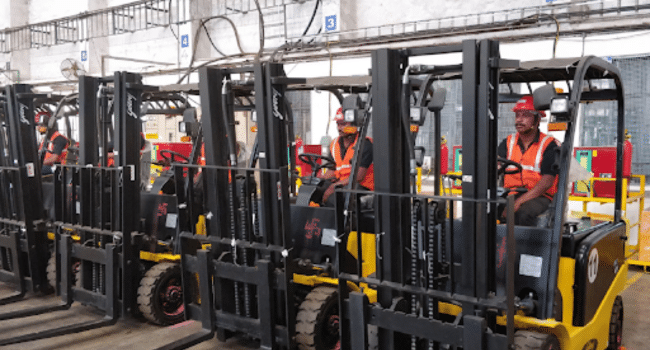Table of Contents
A forklift can make or break a warehouse shift. When used well, it speeds up loading, reduces physical strain, and keeps operations flowing smoothly. However, the same machine, if not handled with care or planning, can become a risk to both people and products. With more facilities opting for a forklift on rent instead of owning one, the focus has shifted sharply towards how safely rented equipment is used, especially when it’s integrated into an already fast-moving supply chain.
Know What You’re Renting: Why Forklift Selection Matters
Not all forklifts serve the same purpose. Choosing the wrong one often leads to corner-cutting, and that’s where safety gets compromised. If you’re operating in a high-rack warehouse, for example, using a low-reach pallet truck may tempt staff to stretch or lift manually. That’s a red flag.
Electric forklifts, ideal for indoor warehouses, reduce emissions and noise. Diesel ones are better suited for rugged, outdoor work. And lithium-ion models are a good fit when you need something that charges fast and works for longer hours.
Let’s not forget niche options. If your warehouse has very narrow aisles or limited turning space, articulated trucks or reach trucks offer better control without the risk of knocking over inventory. Choosing based on fit, not just cost or availability, is where safe operations begin.
Operator Readiness Is Very Important to Overall Safety
Hiring a forklift from a reliable rental provider doesn’t automatically mean the operator knows what to do with it. Whether you’re managing a warehouse in Manali or Ambattur, a forklift hire in Chennai often comes with flexible rental plans, but operator training usually remains your responsibility.
It’s not just about knowing the controls. Operators must understand floor layouts, weight tolerances, cornering at speed, and even how to handle distractions on a noisy shop floor. Warehouses with multilingual crews must also consider communication protocols, like who signals first during a reverse manoeuvre, which can prevent major mishaps.
If you rent a machine with an operator included, always clarify their certification and familiarity with your specific warehouse type. Some premium rental providers like Godrej RenTRUST offer well-trained manpower as part of the package, saving you the effort of onboarding. Even then, it helps to include them in a quick floor walk or site briefing before handing over the load.
Routine Checks Before Use: The 5-Minute Safety Habit
- Tyres and Brakes: Check for wear or leaks. Don’t assume the rental team did it.
- Hydraulics and Mast: Look for smooth lifting and lowering without any jerks.
- Battery/Fuel Levels: Especially in shared-use forklifts. Assume it won’t be charged when you need it most.
- Lights and Horns: Critical for visibility in dim corners or cross-aisles.
- Load Attachments: Check that the forks aren’t bent and the clamps are locking correctly.
These checks don’t take long, and they’re often the only thing standing between a good day and a warehouse shutdown.
Designing the Warehouse Flow Around the Forklift
Many accidents happen not because the forklift was faulty or the operator was careless, but because the warehouse layout didn’t account for forklift movement. Too many blind spots. Poorly marked turning zones. Aisles are crammed with mixed pallets, making it hard to drive straight or brake smoothly.
If you’ve recently opted for a forklift on rent, this is the perfect time to audit your layout. Can the machine turn without bumping into a shelf? Are the speed breakers too high for pallet trucks? Are the racking systems labelled with safe load capacities?
Some facilities create colour-coded zones: red for forklift paths and green for walkways. This helps in places where workers and machines share space. If your warehouse is air-conditioned or experiences frequent temperature fluctuations, select the appropriate model. Condensation on tyres can affect grip more than you’d expect.
Emergency Protocols Aren’t Optional, Especially With Rental Equipment
No matter how carefully you plan, machines break down. And when they do, your team should know exactly what happens next. Is there a standby unit? Do you have warning signage or barriers in place?
Warehouses that rent often assume the rental company will handle breakdowns. But the first response always starts at your end. What do you do when a forklift stops mid-aisle with a full pallet five feet off the ground?
Forklift Model Matching: What to Use and When
To give you a quick comparison, here’s a simplified reference:
| Forklift Type | Best For |
| Electric Forklifts | Indoor operations with low noise and no emissions |
| Diesel Forklifts | Rugged, outdoor use on uneven flooring |
| Lithium-Ion Forklifts | High-productivity setups, fast charging needed |
| Reach Trucks | High vertical storage in limited floor space |
| Articulated Trucks | Warehouses with narrow aisles and tight turning radii |
| Stackers | Medium loads in confined sections |
| Battery Operated Pallet Trucks | Horizontal movement on shop floors and docks |
Choosing from this list isn’t about tech preference; it’s about matching the tool to your risk profile.
Conclusion
No rental contract can replace internal warehouse discipline. The safety of a rented forklift, whether electric, diesel, or lithium-ion, comes down to how well it fits into your warehouse’s layout, your team’s training, and your day-to-day practices.
If you’re considering forklift hire in Chennai or any other city in India, it’s worth looking beyond just the machine. Premium providers like Godrej RenTRUST go a step further by offering operator support and regular maintenance. But even then, it’s your warehouse, your team, and your responsibility.
And safety, more often than not, begins long before the forklift arrives. It starts with asking the right questions.
